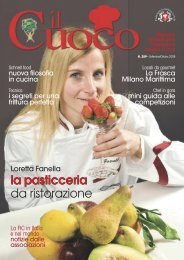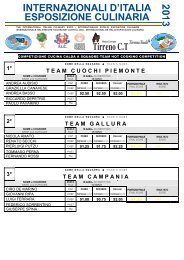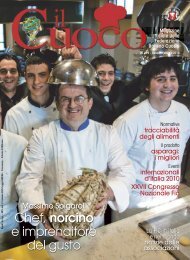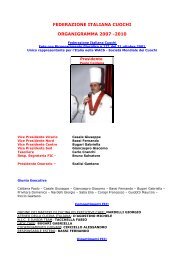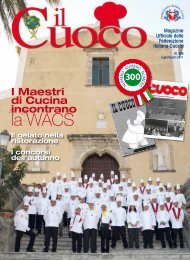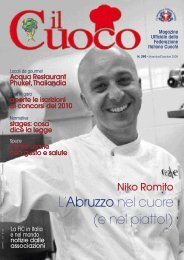ILCUOCOINTERNATIONALty is growing exponentially.This dynamic is so evident that it hasforced the European Association forthe Study Of Diabetes (EASD) to recognisethe prevention and treatment ofobesity as “the most important publichealth problem in the whole world”.More than 65 per cent of Americans areobese or overweight and cases of overweightyoung people have triplicated s-ince 1970.LEAN AND RICHFrom the numerous and most reliablemedical-scientific studies published inliterature it has emerged, with force,that an incorrect diet is one of themost important factors for the increasein the risk of the occurrence of cardiovasculardiseases, tumours and diabetes.In order to adopt a correct lifestyle and a healthy diet the following isrecommended: regular exercise, on averagefrom 30 to 60 minutes a day formost days of the week; avoid both temporaryand prolonged situations of excessweight/obesity; avoid the excessiveintake of alcohol which corresponds tono more than one glass a day for womenand two glasses a day for men; do notsmoke; adopt a balanced diet, characterisedby control of the overall numberof calories eaten and an appropriatecomposition of the various macro andmicro nutrients; increase the intakeof fruit and vegetables (up to around400 grams a day which is the equivalentof around 4-5 portions); prefer sourcesof complex carbohydrates and increasethe intake of whole-grain cereals (bread,pasta, grissini produced with wholemealflours); increase the intake of pulses; eat2-3 portions of fish a week; prefer theuse of vegetable dressings (vegetableoils) in the place of condiments with ahigh content of animal fats (butter,lard); limit the intake of foods with ahigh content of fats (for example, hotdogs, sauces, creams, dairy products,charcuterie), preferring “low-fat” products(such as low-fat yogurt andskimmed milk); limit the intake offried food; limit the intake of meat andpoultry to a maximum of 3-4 portionsa week; limit the additional use of salt(with respect to that naturally containedin the foods) within the dailyamount of 5-6 g. of added salt, equal toabout one teaspoon full; limit the intakeof foods/drinks with high concentrationsof sugars (for example,pastry products and sugary drinks);avoid the daily use of food supplements.THE MEDITERRANEANMODELThree great traditions have been i-dentified, each characterised by theirown peculiar traits: the Mediterraneanmodel, the North-American model andthe Asiatic model (which contains certainimportant traditions and cultures,such as the Japanese and Vietnameseones, and the Chinese one). From the resultsof analysis carried out, it has e-merged that strict coherence with respectto the recommendations suggested atscientific level make the Mediterraneanmodel one of the most efficacious interms of wellbeing and prevention ofchronic pathologies.Lastly, in the presence of the fact thatdietandlifestyleareabletoconstitutea fundamental part of effective strategiesfor the prevention of the occurrence ofthe main chronic diseases, an attempthas been made to quantify the repercussionsof the practical adoption ofsimilar strategies, not only in medicalbut also in economic-financial terms.The World Health Organisation/WHO) defines health as “a complete s-tate of physical, metal and social wellbeingand not only an absence of diseasesor infirmity”, while it defines a healthylife style as “a way of living aimed at reducingthe risk of diseases and prematuredeath”. Not all pathologies can beavoided (such as heart attack and cancer),but in many cases, an attentive preventioncan reduce the risk of their occurrenceor make it less likely.DIETARY HABITSAmong the components of a correctlife style, dietary habits play a particularlyimportant role. The relationship betweendiet and the state of health hasbeen recognised by man since pre-historictimes. History in fact shows thatthe human race learnt right from the s-tart to recognise the effect of differentfoods on the organism and, consequently,through the application of criteriaof choice and selection on huntedand gathered food, to avoid eating harmfuland poisonous foods. The attentionof man for health and preventiongrew constantly over time, in particularwith the introduction of techniques forcooking and preserving foods (drying,salting and smoking), which allowedman to dispose of food for long periodsof time in total safety. Also, as a resultof this, the diversity in the meaning ofthe terms diet and nutrition is clear. Thefirst indicates the selective consumptionof foods in an aware way, while the secondrefers to an autonomous process ofassimilation, transformation and metabolismof food.All of this, corroborated by studies onspecific research, could be useful for uschefs in order to have a more positive visionof human needs useful for a correctdiet and accompanied by an appropriatelife style. Once again the excellence of theMediterranean diet has been confirmed,which we professionals in the handlingof Italian food know how to interpretvery well.SEE PAGE 48FOR THEITALIAN TEXTTrendsand traditions:extra-virgin olive oilBy Alessandro Circielloand Luigi Cremona,The chef and the food critic discuss thetopic of extra-virgin olive oil in the k-itchen. A fundamental, healthy ingredientable to enhance the flavour of dishes. Oncondition that you choose a quality one.Alessandro, do you think that extra-virginolive oil, called “evo oil”for short, is the basic ingredient ofthe Mediterranean diet and one ofthe most characterising elements ofour cooking?“I certainly do, Luigi. No Italian cui-78|
sine can exist without evo oil. Added atthe end, uncooked, it gives a touch offlavour and Italian spirit to dishes”.The use of oil is very old. Justthink that ancient peoples, includingthe Egyptians, the Greeks and the Romans,used it not as a dressing but alsoas a medication or as a prize forgreat warriors.“ Let us not forget that if man makeswine, nature makes oil. Man must onlyextract it from the drupes at the besttime and store it in containers, whereit can be kept at the best conditions toachieve the delicate aroma, given by themild temperatures of the areas near thesea or the lakes, or the decisive, fruityflavour of the dryer, colder inland areas.Certainly, we chefs have the hard taskof understanding which is the best oilto use for each dish. We can’t gowrong”.A wrong combination can jeopardisethe result of the recipe, while aparticularly successful one enhancesits balance and flavour. It would beagoodideaifeverychefwidenedhisknowledge about it.“It seems trivial, but this isn’t thecase. Perhaps we do not yet attach e-nough importance to oil. Extra-virginoil presents a variety of flavours andperfumes, which is combined accordingto the dish in question and to the varioustype of cooking. For example, asweet, soft oil, with a subtle perfume isused for fried dishes and fried fish, butalso to dress salads and sour vegetables.Instead, a medium-fruity, round, fragrantoil is stronger and combines wellwith meat in the Alba style or withtomato, with fried lake or river fish orwhite meats, but also with pulses andfish soups. Finally a very fruity, penetratingoil which stings the throat ismore suitable for dressing boiled beef,braised meats and red grilled meats. Itisn’t always easy to try to enhance thetaste and flavour of a dish, but it is theduty of we chefs, even if each of uschooses the combination followingour own personal taste and imagination”.Oil lends itself to different types ofcooking. It can be used in variousways, giving different flavours andtastes to the palate. We must alwaysmonitor the temperature of the oil,because if it reaches a certain heatthreshold, toxic substances can form.“You’re right Luigi, in fact the tablesof the Institute of Health indicate“smoking points”, i.e. the temperatureat which acrolein, a toxic substance,forms. For seed oils, the maximumlimit is 190°C, while for extra-virgin o-live oil it is 220°C. This is why it is fundamentalto monitor temperatureswith special thermometers, also becauseifyoufrywithoilwhichisn’thotenough, you incorporate a higher percentageof fat into the food giving anunpleasant final result. In the restauranttrade, if you do not have to prepareforalotofcovers,itisalwaysbettertouse a frying pan changing a quality oilfrequently, rather than filling lots of fryersand re-using the oil too manytimes”.Oil is also indispensable in onionand herbs browned in oil and inbrowning as well as for frying.“In fact, oil is the ideal element forbrowning onion and herbs. In this wayan ingredient is cooked in just a littlehot fat, at a high heat, until it isbrowned, i.e. sealed, on all sides. Thistypeofcookingisusedasabaseformeat and fish sauces, for pasta or risottos,but also for stewed vegetables or forsecond courses of meat and fish. While,thanks to the action of heat, browning




